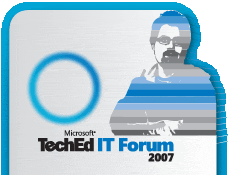IT FORUM: Windows Server 2008

I'm at the IT Forum event this week - it's a week long tech-fest about current and future technologies from Microsoft. This year's event has 5,200 delegates and we're all sitting in a conference centre on the shores of Mediterranean in Barcelona (not quite as wonderful as it sounds - it was 10-degrees when we got here, and I didn't even think I needed a coat...brrrr). We're joined this year by around 100 IT staff from public sector organisations around the UK, all here for the same thing - to get a behind-the-scenes, and in-depth look at the software that runs their services, and to see how new releases can help to improve your service delivery.
I'm going to do my best to bring you some of the headlines of the event, and their relevance to you.
Windows Server 2008
The opening keynote focused on Windows Server 2008 - the first of a launch wave of products due to be launched on 27th February. It will bring a wide range of new features and functionality which will be useful, such as:
- Network Access Protection - allowing you to build policy based protection for devices connected via wired connections, wireless or VPN to your network. With this, you can set a quarantine mechanism, where newly connected devices are automatically quarantined until they have run through a security policy check, and that allows you to enforce your policies (eg, all Windows devices must have the latest security updates installed and up-to-date anti-virus definitions). The ability to differentiate between policies for wired and wireless is useful - for example, it could help you to minimise inconvenience to wired staff, whilst maximising security for transient wireless users who are more likely to be using their computers out of the office, where they may be more at risk of security threats.
- Security by design - the core idea of Windows Server 2008 is that you only install the components you need, and not the reverse (today's model installs virtually everything on the server, and expects you to switch things off). This will provide better base-line security, and mean you will need to spend less time patching your servers with the latest updates. The outcome? Improved up-time, and less time spent fire-fighting.
More detail on the Windows Server 2008 and Hyper-V announcements
Virtualization*
This has been the buzzword of the afternoon. And what's available helps meet some of the the unique challenges of public sector IT systems supporting a range of different departments - the expectation from users that they can run whatever applications they want, at the drop of the hat. Oh, and that you'll keep the IT Services up and running whenever they need access.
We've got virtualization technologies coming out of our ears at the moment - Applications virtualization (through SoftGrid/Microsoft Desktop Optimisation Pack); Presentation virtualization (through Terminal Services); Desktop virtualization; and enhanced Server virtualization (through Windows Server 2008).
- Server virtualization under Windows Server 2008 has been officially called "Hyper-V" - an enhanced way of running and managing virtual servers, with an enhanced set of services through System Centre (System Centre Virtual Machine Manager & Data Protection Manager were announced today), designed to better integrate the management of your physical and virtual IT services. On the stage here at IT Forum, Bryon Surace (no, not a typo) showed us a server hosting 4 flavours of Windows Server 2008 (including the 32-bit and 64-bit versions) running alongside a full Suse Linux server, in a single virtual environment. He also announced new tools to integrate Linux servers onto the Windows Server 2008 platform.
- Application virtualization options seem to be expanding rapidly at the moment. Although there are not a wave of new product announcements (although Beta 1 of the Microsoft Application Virtualization was announced), it has become clearer how the different approaches can allow you to enhance your service delivery, and give your users a little more flexibility without having to compromise your core service delivery.
Posted by Ray, at IT Forum
* Which is it? Virtuali*sation or Virtualiz*ation? Normally, I go for UK spellings, but the latest versions of the Oxford dictionary seem to be shifting to a more agnostic approach on Americanised spellings - on this occasion, I'm going to go with it, because we've got product names in here too. Does it really matter? Do you care? I've know that some of the online training providers find they get a lower completion rate on versions using American spellings - sometimes 50% of the normal rate. Does that mean I've lost half of you half-way through this article? Discuss...